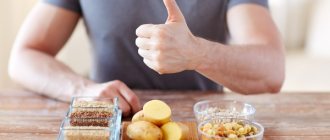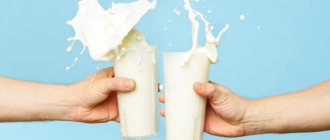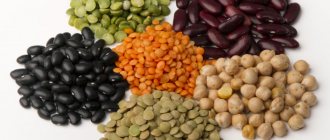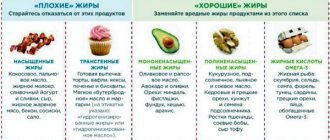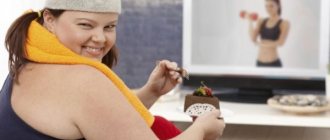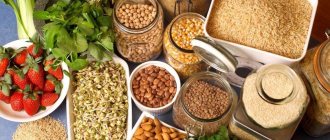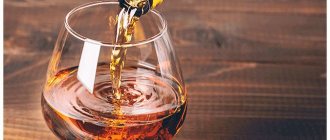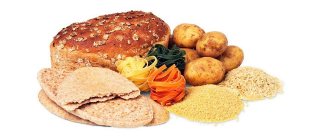What do I need to know about the different types of fat in food?
- Limit unhealthy fats. A diet high in cholesterol, saturated fat and trans fat can cause unhealthy cholesterol levels. Unhealthy cholesterol levels increase the risk of heart disease. Cholesterol: Limit cholesterol intake to 200 mg per day. Cholesterol is found in meat, eggs and dairy products.
- Saturated fat: Limit saturated fat to less than 7% of your daily calories. Ask your dietitian how many calories you need each day. Saturated fat is found in butter, cheese, ice cream, whole milk and palm oil. Saturated fat is also found in meats such as beef, pork, chicken skins and processed meats. Processed meats include sausage, hot dogs and bologna.
- Trans fats: Avoid trans fats as much as possible. Trans fats are used in fried and baked foods. Products labeled as fat-free may contain up to 0.5 grams of fat per serving.
- Monounsaturated fats. They are found in avocados, nuts and vegetable oils such as olive, canola and sunflower oil.
Why should fats not be underestimated?
First, let's figure out what fats are and why people need them.
So, fats in the Big Dictionary of Medical Terms are complete esters of glycerol and higher fatty acids; are part of lipids; They are of great importance as an energy, plastic and heat-insulating material in the human and animal body.
The picture is attached.
Has it become clear? Only that it is something very important.)
Let's clarify the main functions of fats:
- Construction - fats are part of all cell membranes and tissues
- Energy - when burning 1 gram of fat, the body receives about 9 kcal of energy
- Protective - all important human organs are covered with a protective layer of fat
- Storage - fats store energy and water. Human reserve reserves account for 10-20% of body weight
- Regulating - fats participate in metabolism. Synthesizes vitamins A, D, E, K
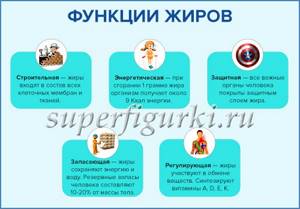
Therefore, no matter how much you would like to, you cannot give up fats. From foods without fats, your body will only get dry skin, hair loss, fatigue and metabolic disorders. A deficiency of fats in the body leads to increased cholesterol in the blood and deterioration of the cardiovascular system . In addition, low-fat diets most often end in weight gain because in a stressful situation the body stores more additional fat reserves.
What foods should I limit or avoid?
- Grains: Snacks made from partially hydrogenated oils, such as chips, regular crackers, and butter-flavored popcorn
- High-fat baked goods such as cookies, croissants, donuts, pies, cookies and pastries
- Whole milk, 2% milk, yogurt and whole milk ice cream
- High-fat cuts of meat (t-bone steak, regular hamburger, and ribs)
- Roasted vegetables or vegetables in creamy or rich sauces such as cream or cheese sauces
- Butter, margarine
Low-fat diet: prohibited foods
The most strict version of a low-fat diet involves reducing the amount of fat to 10% of the daily diet.
A low-fat diet involves excluding the following foods:
- fat meat;
- fried foods;
- chocolate;
- fatty dairy products;
- seafood;
- sugar and sweet baked goods;
- fatty sauces;
- condensed milk;
- margarine, spread, back fat;
- sausages, wieners, bacon;
- fast food.
What products should we include?
- Grains: Whole grain breads, cereals, pasta and brown rice
- Fat crackers and pretzels
- Fresh, frozen or canned vegetables (unsalted or low sodium)
- Skim (skim) or 1% milk
- Chicken or turkey without skin
- Unsaturated oil such as canola, olive, peanut, soybean or sunflower oil
Low fat foods
The last two food groups are recommended for regular consumption. These should form the basis of your diet:
- products with a low amount of fat (3-9.9 g). These are kefir, milk, low-fat cottage cheese, milk ice cream, meat, say, beef, low-fat lamb, different types of fish, such as pink salmon, herring, horse mackerel, mackerel and others. From sweets – fondant candies. Eat this food without fear. Even if there are a lot of these products in your diet, it will not harm the body;
- low-fat products (up to 3 g). These are protein milk, legumes, cereals, low-fat cottage cheese, low-fat fish, bread. Eating them is absolutely safe even for those on a strict diet.

How can you reduce fatty foods?
- Read food labels before purchasing food. Choose foods that contain less than 30% of your calories from fat. Choose low-fat or low-fat dairy products. Remember that low fat does not mean no calories. These foods still contain calories, and too many calories can lead to weight gain.
- Trim fat from meat and avoid fried foods. Remove all visible fat from meat before cooking it. Remove skin from poultry. Do not fry meat, fish or poultry. Instead, bake, broil, boil or broil these foods. Avoid fried foods. Eat baked potatoes instead of French fries. Steam vegetables instead of frying them in butter.
- Add less fat to your food. Use imitation bacon bits on salads and baked potatoes instead of regular bacon bits. Use low-fat or low-fat salad dressing instead of regular dressing. Use low-fat or butter-flavored butter instead of regular butter or margarine on popcorn and other foods.
Diet without fats and carbohydrates “Soup for 3 days”
The diet is designed for 3 days and allows you to lose 3-4 kg of excess weight. The main dish of the diet is soup without salt and seasonings; it can be eaten constantly without taking long breaks between meals.
So, let's cook soup for weight loss:
- Head of cabbage;
- 3 onions;
- 3 green sweet peppers;
- A jar of canned green peas.
Finely chop the vegetables, add cold water and bring to a boil. Reduce heat, add green peas and cook for 20 minutes.
Diet plan:
Day 1 – soup and fresh vegetables.
Day 2 – soup and fresh fruit, except bananas.
Day 3 – soup, fruits, vegetables and a piece (100g) of boiled veal.
After three days, the diet without fats and carbohydrates can be repeated. There can be no more than three repetitions in total, after which you should take a break for 3-4 months.
How can I reduce fat in recipes?
Substitute fatty or low-fat ingredients. This may make baked goods drier than usual. You may need to use a low-fat spread for cooking on pans to prevent food from sticking. You may also need to adjust the amount of other ingredients, such as water, in the recipe. Try this:
- Use low-fat or light margarine instead of regular margarine or spread
- Use lean turkey or chicken breast or lean ground beef (less than 5% fat) instead of hamburger.
- Add 1 teaspoon of canola oil to 8 ounces of skim milk instead of using cream or half and half.
- Use shredded zucchini, carrots or apples in your bread instead of coconut.
- Instead of cream cheese, use low-fat cottage cheese, regular tofu, or low-fat ricotta cheese.
- Use 1 egg white and 1 teaspoon olive oil, or ¼ cup low-fat egg substitute instead of a whole egg.
- Substitute half the butter called for in the recipe with applesauce when you bake. Use 3 tablespoons cocoa powder and 1 tablespoon olive oil instead of the baking chocolate square.
How can I increase my fiber?
Eat enough high-fiber foods to get 20 to 30 grams of fiber each day. Slowly increase your fiber intake to avoid stomach cramps, gas and other problems.
- Eat 3 servings of whole grains every day. Eat whole grain breads, such as whole wheat bread. Whole wheat, whole wheat flour, or other whole grains must be listed as the first ingredient on the food label. Replace white flour with whole wheat flour or use half of each in recipes. Whole wheat flour is heavier than white flour, so you may need to add more yeast or baking powder.
- Eat high fiber cereal for breakfast. Oatmeal is a good source of soluble fiber. Look for grains that have bran or fiber in their name. Choose whole grain foods such as brown rice, barley and whole wheat pasta.
- Eat more beans, peas and lentils. For example, add beans to soups or salads. Eat at least 5 cups of fruits and vegetables every day. Eat fruits and vegetables with the skin on because the skin is high in fiber.
Vegetarian diet without fat
A vegetarian diet lasts seven days and allows you to get rid of 3 to 5 extra pounds. The menu of this fat-free diet is dominated by fresh fruits and vegetables, vegetable salads without oil, and dishes made from boiled and stewed vegetables. Once a day, a dish of buckwheat, oatmeal, millet or barley is provided. Twice a week it is allowed to consume 50 g of cottage cheese with fruit or kefir (1 glass).
An example of a vegetarian diet menu:
Breakfast (to choose from):
- Salad of cucumbers, tomatoes and Chinese cabbage with herbs, two apples, green tea;
- Oatmeal porridge with water, any fruit, tea;
- Fruit salad of pear, apple, apricot and plum, two toasts, tea.
Breakfast 2:
- Any fresh vegetables.
Lunch (optional):
- White cabbage soup with celery and sweet pepper, zucchini stewed with tomatoes in its own juice, black bread (30g), green tea;
- Stew of eggplants, cabbage, tomatoes, onions and zucchini, fresh vegetable salad, bran bread (30g), tea;
- Boiled cauliflower with sour cream (1 tbsp), fresh vegetable salad, tea.
Afternoon snack:
- Fresh fruit, twice a week - a glass of kefir or cottage cheese (50g).
Dinner (to choose from):
- Loose buckwheat porridge (in this case, breakfast should be vegetable), tomato juice, pear or apple;
- Grilled vegetables (no rough crust), pineapple, peach and mango salad (you can make any fruit salad from seasonal fruits);
- Pumpkin baked in the oven with raisins or dried apricots, two apples.
A vegetarian diet without fat is best followed in the summer-autumn period, when there is a maximum range of fresh vegetables and fruits.


